When your K/D tally is at stake it’s pretty tempting to buy a premium gaming mouse with all the latest bells and whistles. But that can be a costly move that can see you paying upwards of $150 USD—that’s coin that could go towards a brand-new processor instead.
The truth is you won’t lose much performance going for a cheaper option. In fact, you can get a top-performing mouse that—barring the sensor, which is usually more modest than in premium devices—is virtually identical in build quality and styling and with equally quick buttons.
That’s not to say all budget gaming mice are alike. Admittedly, at the lower end of the market there tends to be more variation in the build quality, weight, and button configuration than at the top end, so you’ll still want to do your homework before you buy.
Or, you could just peruse our list of best budget gaming mice (below). We’ve already done the research on your behalf by extensively testing a cohort of mice, sorting the wheat from the chaff, so that what’s left is the best of the best. We’ll keep updating our chart as we review more mice and find even better products.
For the criteria we use to review budget gaming mice and some useful buying advice, read our postscript explainer below. For even more options, see our complete roundup of the best gaming mice, featuring both wired and wireless picks at various prices points.
Updated 2/27/24 to include the Keychron M6 Wireless to our recommendations. This mouse packs a lot of functionality into a mouse that costs just $49, boasting a 26K Optical Sensor, two scroll wheels, a comfortable thumb rest, and a dedicated scroll wheel switcher button — all of which help max out the control you have in your game.
Logitech G502X – Best wired budget gaming mouse / Best overall
Pros
- The 25K Hero sensor is very proficient event at high DPI settings
- The button are extremely well placed for accessibility
- The rubber thumb rest provides plenty of grip
Cons
- Not including swappable trigger buttons seems like a missed opportunity
- There’s no RGB lighting except a small DPI indicator light
- The mouse wheel is quite noisy
Price When Reviewed:
69.99
The G502X sports a number of nice upgrades over its predecessor the G502—which in its own right was a big hit with gamers—including a super-quick and accurate 25,600 DPI sensor. But what really sets this mouse apart is its button configuration—which is near perfect. It features 13 programmable button options in all, including highly sought-after DPI up/down buttons and a four-button mouse wheel. But the gem in its crown is a trigger button near your thumb, which makes letting off that must-hit command or macro just that much quicker in fast-paced games.
On top of that, the G502X sports a refreshed design that makes it eminently more comfortable and easier to move. I especially like a new, improved rubber thumb grip that replaces the plastic one from the G502, and the mouse’s longer dimensions that make it a much better fit for large hands.
Read our full
Logitech G502X review
Roccat Kone Pro – Best wired budget gaming mouse runner-up
Pros
- The 19,000 DPI sensor is very precise, and the buttons are quick and clicky
- An ingenious design elevates your index finger ready to fire
- A lightweight body adds to its speed and precision and prevents fatigue
Cons
- No dedicated DPI button means you can’t as easily switch DPI settings
- Wired connectivity only, so you’ll need to plug it in to play
- The mouse wheel lacks lateral left / right clicks
Price When Reviewed:
39.99
The wired Roccat Kone Pro is designed for precise targeting thanks to its lightweight design and formidable 19,000 Owl-Eye DPI sensor, which in our playtesting proved an excellent performer in fast-paced FPS games. Clicks are also extremely quick thanks to Titan optical switches in the buttons and a slight left-to-right slant on top that perfectly poises your index finger on the left main button ready to fire.
A thin plastic outer layer keeps the Kone Pro’s weight down to just 66 grams, so that it glides across your mouse mat smoothly and with minimal effort. While the Kone Pro doesn’t have a dedicated DPI button, you can still change DPI on the fly in games by assigning this function to one of its other buttons in the supporting Roccat Swarm software app.
Read our full
ROCCAT Kone Pro review
Keychron M6 Wireless – Best wireless gaming mouse

Pros
- Precise and accurate 26K sensor
- The sloping design elevates your trigger finger
- Two scroll wheels enhance your play
Cons
- The build quality could be better
- The mouse feet aren’t 100 percent PTFE
- There’s no RGB lighting
The Keychron M6 doesn’t have the most robust build quality you’ll find in a gaming mouse, but it does offer a lot of functionality that you just can’t get elsewhere for the bargain basement price tag it wears. I’m talking about its large and comfortable thumb rest, two scroll wheels (one with four clicks), useful side buttons, and its accurate 26K optical sensor. You get all that for a mere $49. Considering the closest match I can think of feature-wise is the $99 Logitech MX Master 3S, the Keychron M6 seems like exceptional value!
This mouse also supports all three connectivity types — 2.4GHz Wi-Fi, Bluetooth, and a wired connection — making it a highly versatile option that you can hook up to just about any PC or laptop you own. Because of its cheaper build quality, though, it’s definitely one to keep safely housed out of harm’s way.
Read our full
Keychron M6 Wireless review
Keychron M3 – Best wireless gaming mouse runner-up
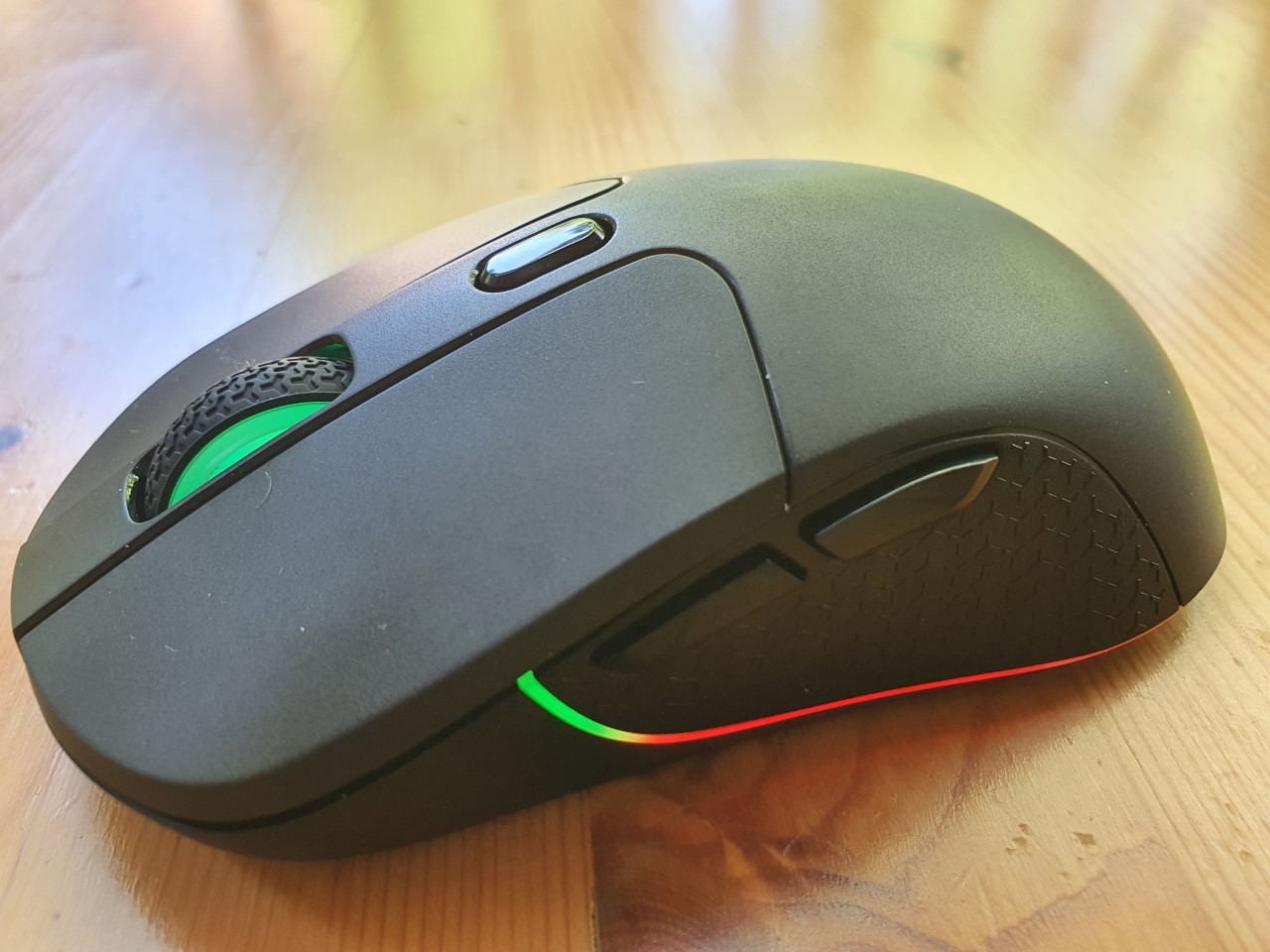
Pros
- Very fast and precise 26,000 DPI sensor
- Well-proportioned and very comfortable
- The quickest buttons I’ve ever used
Cons
- It would have been more convenient for the DPI button to be placed where the RGB button currently sits
- Mac users will have to wait on the software app
- The M3 is currently only sold through Keychron’s online retailer
With a flawless 26,000 DPI sensor, a timeless and comfortable design, responsive buttons and swish RGB lighting, the Keychron M3 is the complete package, worth every bit of its $49 price tag and possibly even a dime more. For a mouse with all three connectivity types—wired connectivity via a USB cable, 2.4GHz Wi-Fi, and Bluetooth wireless connectivity—it’s also exceptionally light, weighing in at just 79 grams.
All this value would have come to nada without some decent performance, which is just what the M3 Keychron delivered in our playtesting. From spinning around to catch foes from behind, to zipping up our cursor to flush out snipers dug into camping spots, the Keychron M3 handled every movement smoothly and without a hint of lag. It also came bundled with a few extras in the box, including not one but two separate dongles (one for USB-A and another for USB-C) so that we could connect up to just about all our devices.
Read our full
Keychron M3 review
Razer Viper V3 Hyperspeed – Best for esports

Pros
- Quick and accurate sensor
- High sensor positioning
- Very long battery life
- Hyperpolling support
Cons
- No RGB lighting
- 2.4GHz Wi-Fi connectivity only
- Weighs less than 3 ounces
Price When Reviewed:
69.99
Razer’s Viper V3 Hyperspeed gives you a taste of pro gaming functionality at half the price of some other pro-grade gaming mice. So, what’s the catch? Very little actually — a modest RGB-free design and no Bluetooth functionality, is all. In my playtesting I found its 30K Razer Focus Pro sensor to be incredibly accurate and quick and the Razer Gen 2 Mechanical Switches in the buttons felt soft and responsive — just ideal for FPS.
This mouse’s handling is also as good as it gets thanks to a full-bodied grip with lots of length in the fingers. Connectivity is via a 2.4GHz Wi-Fi dongle only. The mouse is powered by a single AA battery which provides a whopping 280-hour battery life. While the Viper V3 Hyperspeed comes with a standard 1,000Hz polling rate out of the box, it also supports 4,000Hz HyperPolling via a Razer HyperPolling dongle (sold separately).
Read our full
Razer Viper V3 Hyperspeed review
HyperX Pulsefire Haste 2 Wireless – Best for esports runner-up
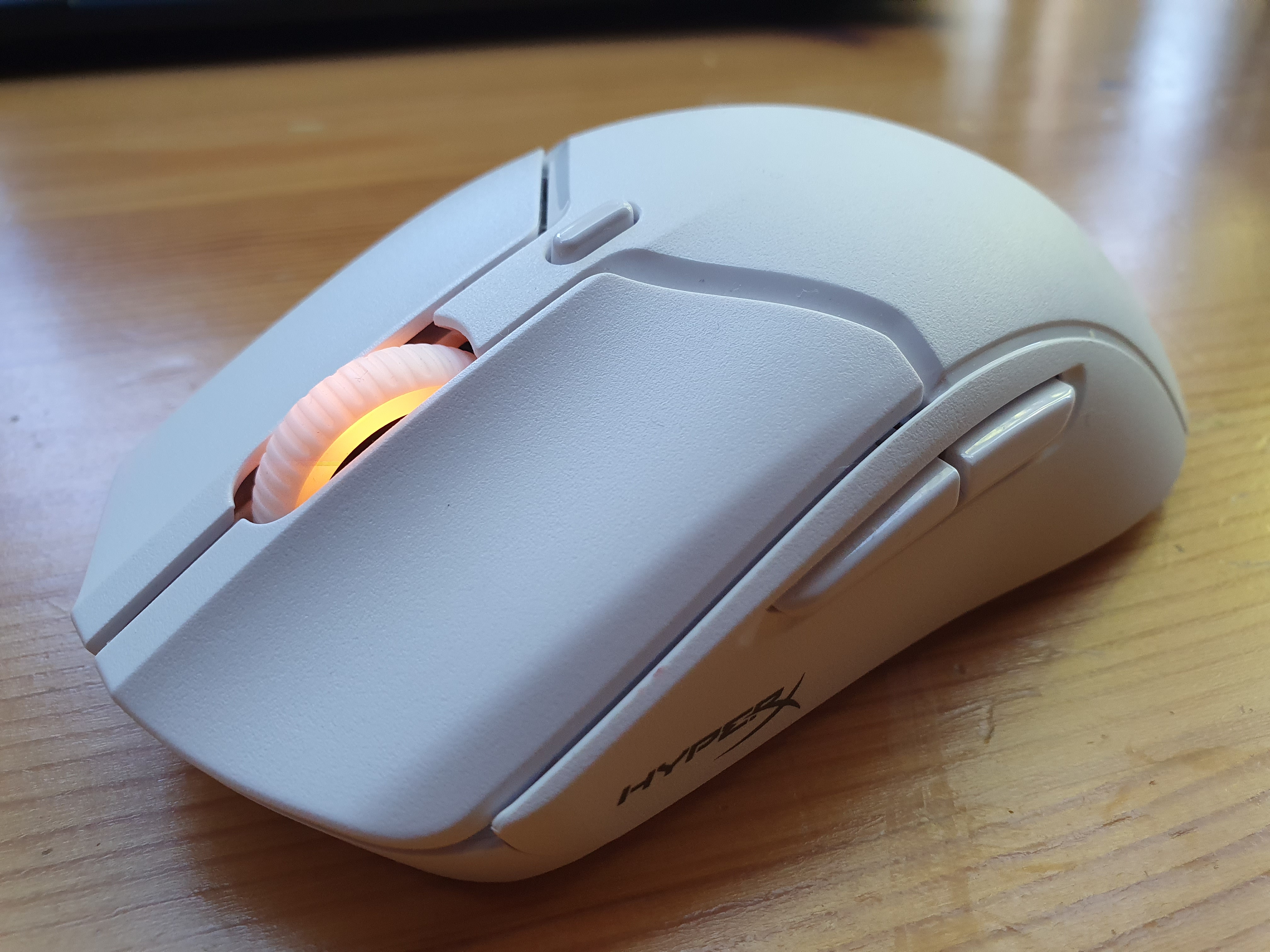
Pros
- The solid top back is comfortable and stylish
- Its 26,000 DPI sensor can target at lightning speeds
- Bluetooth functionality makes it one of the most versatile esports mice you can get
Cons
- The compact buttons can feel a bit cramped at times
- There’s just the one RGB zone to play with
- It’s more expensive than its predecessor
Price When Reviewed:
$89.99
The six-button HyperX Pulsefire Haste 2’s symmetrical design and 26,000 DPI sensor give it laser-like pinpoint precision in games, a fact which in itself doesn’t make it anything special. What sets it apart is that it weighs just 2.15 ounces (61 grams)—that’s lighter than more expensive pro-grade esports mice like the Razer DeathAdder V3 Pro and Logitech G X Pro Superlight. Suffice to say it’s super quick off the mark.
Achieving such a lightweight design is quite an extraordinary feat by HyperX for two reasons: The Pulsefire Haste 2 has a hard top back rather than the perforated one we saw in its predecessor the Haste 1, which also means it’s better suited to claw grippers. It also sports Bluetooth as well as 2.4GHz Wi-Fi connectivity, the extra Bluetooth functionality being still a rarity among pro-grade esports mice. All these factors make it one of the best value esports mice you can buy right now.
Also be sure to check out the Haste 2 Wireless’s forebear, the HyperX Pulsefire Haste Wireless, which is still an excellent all-round performer for fast action games.
Read our full
HyperX Pulsefire Haste 2 Wireless review
Logitech G203 LightSync – Best ultra-budget gaming mouse
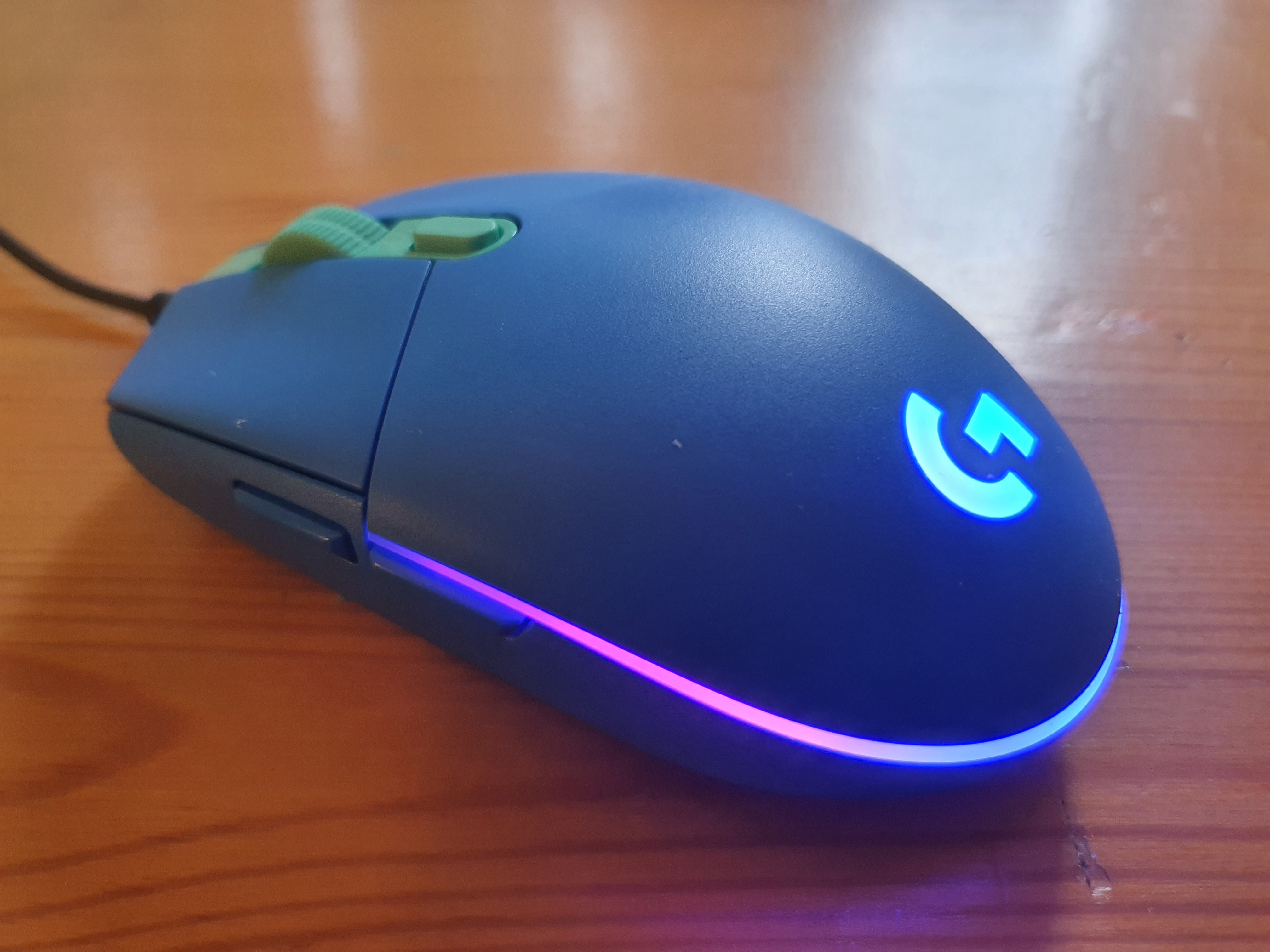
Pros
- A comfortable design that resembles more expensive esports mice
- Sturdy and well-built
- The RGB lighting really pops
Cons
- Some sensor lag was experienced with large, fast movements
- The sensor’s lift-off distance is higher than some mice
- The RGB logo on the top isn’t customizable
Price When Reviewed:
$39.99
The G203 proves gaming on a budget needn’t be glum, combining style, performance, and comfort for a shoestring price. This wired mouse sports a small ambidextrous body and familiar six-button configuration that resembles premium esports mice, except it has a more rounded back end that gives palm grippers a high level of precision.
In terms of hardware performance, the G203’s buttons feel quick and clicky. Its 8,000 DPI proprietary gaming sensor may not be as quick as some rival sensors, but it’s still highly accurate and performs decently in just about every casual gaming scenario.
In our review, we heaped praise on the G203 for its dazzling RGB lighting band and Logitech logo that light up your mouse pad with pops of color, the band of which also splits into three lighting zones customizable in the Logitech G Hub app.
Read our full
Logitech G203 LightSync review
Razer DeathAdder V2 X Hyperspeed – Best dual-purpose budget mouse for gaming and productivity
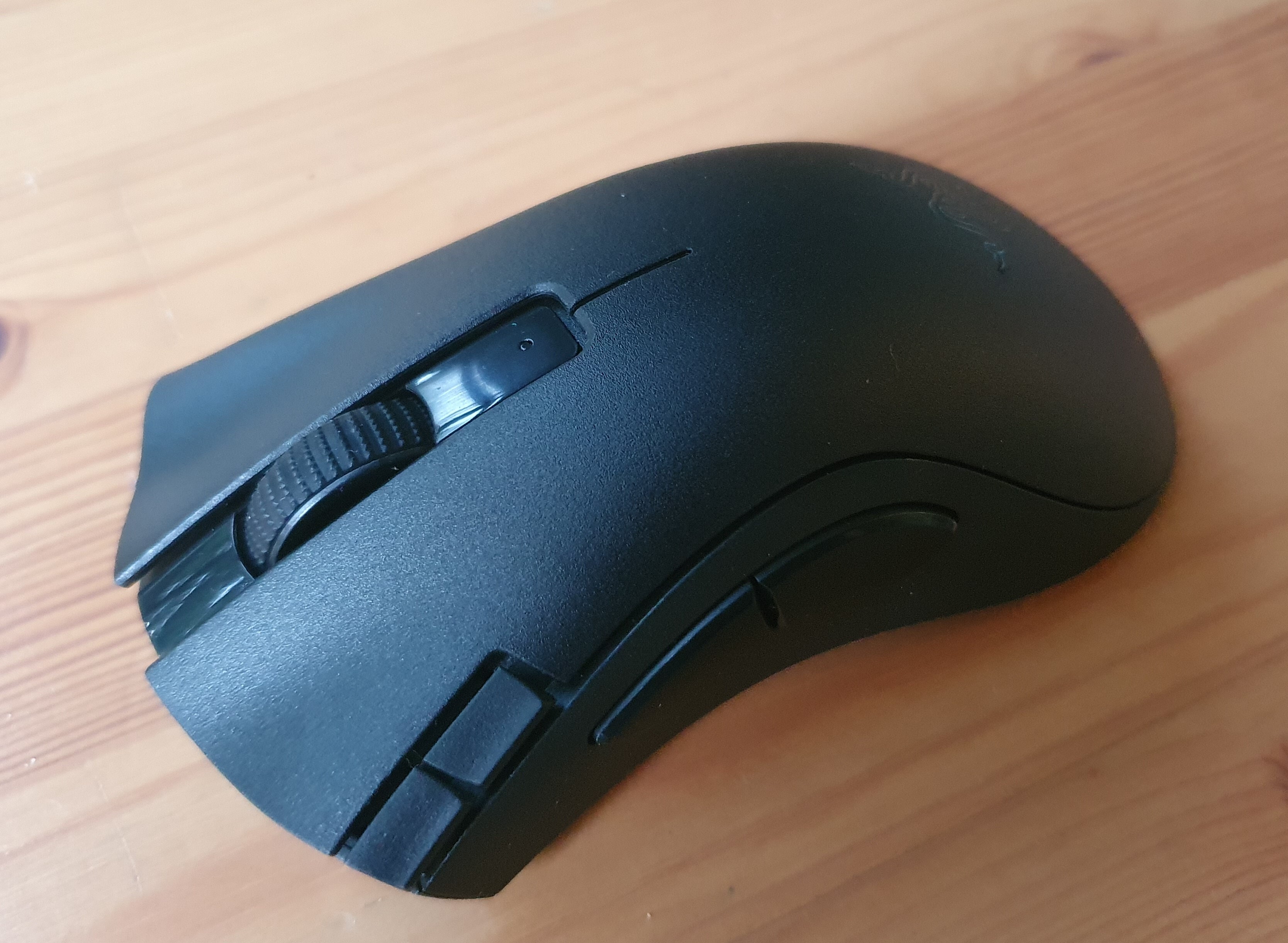
Pros
- Comfortable, ergonomic design
- Dual Wi-Fi and Bluetooth connectivity
- Long battery life
Cons
- No RGB lighting
- Slightly slower than top-shelf gaming mice
Price When Reviewed:
$59.99
A stealthy profile is this wireless mouse’s biggest advantage—it sports an entirely matte-black body with no RGB lighting, meaning your work colleagues will be none the wiser about the gaming power that rests beneath your palm.
The V2 X Hyperspeed packs a very capable 14,000 DPI sensor that performs a treat in AAA games like Metro Exodus. Its seven buttons sport Razer second-generation mechanical switches, which Razer says makes them last up to 60 million clicks.
The V2 X Hyperspeed offers the convenience of dual wireless connectivity, allowing you to switch between 2.4GHz Wi-Fi and Bluetooth with the flick of a button. It’s also highly portable thanks to a long battery life, which provides approximately 235 hours in Wi-Fi mode and up to 615 hours in Bluetooth mode on a single AA battery.
Read our full
DeathAdder V2 X Hyperspeed review
Roccat Kone XP – Best for MMO, RPG, and RTS gaming
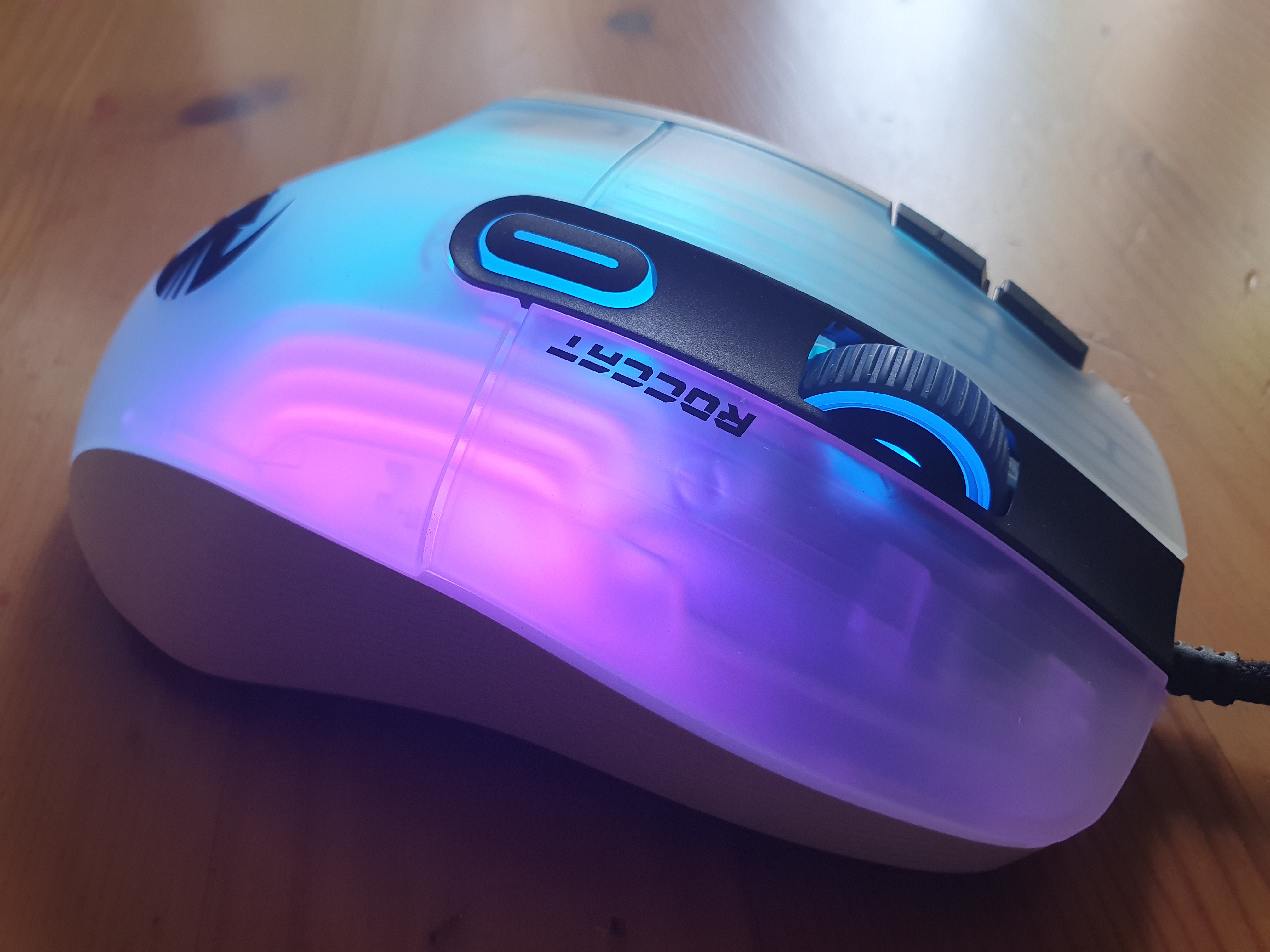
Pros
- Stunning RGB lighting that lights up the whole top section
- The Owl-Eye sensor is highly accurate and powerful
- The 15 buttons can be customized with up to 29 functions
Cons
- The button layout can be confusing before you get the hang of it
- Some gamers may not like the bold RGB
- The supporting Swarm software could do with an update
Price When Reviewed:
74.99
The Kone XP is the flashiest mouse we’ve had the pleasure of testing, featuring no less than eight customizable RGB “pipelines” illuminated by 22 LED lights, yet it’s also a solid performer. With an impressive contingent of 15 buttons—customizable to 29 functions—the Kone XP is especially suited for MMO, RPG, and RTS games that require players to quickly deploy a high number of commands or macros.
Under the hood, the Kone XP sports a 19,000 DPI Owl-Eye sensor based on the flawless PixArt PMW3370, which has proven its worth among competitive gamers.
In our PCWorld review we found it to be precise and accurate in games like Cyberpunk 2077. We also liked the Kone XP’s four-directional scroll wheel, which felt sturdy and responsive.
Read our full
ROCCAT Kone XP review
Roccat Kone Air – Best battery life

Pros
- Precise Owl-Eye sensor
- Durable Titan Switch Optical switches
- Impressive battery life up to 800 hours
- Dual wireless connectivity
Cons
- Uneven weight distribution with one battery
- No wired mode
- Limited to a single profile
- Possibly too heavy and large for esports
Price When Reviewed:
$79.99
Popping just two AA batteries in the Roccat Kone Air gives you a whopping 800 hours battery life in Wi-Fi mode. Suffice to say, the Kone Air has one of the best battery lives of any wireless mice you can buy. That said, it’s definitely a mouse for gamers who like a solid weight in their hand — it weighs all of 147 grams when loaded with batteries — so it’s not going to be great for esports. Its hardware is nonetheless very respectable, and in our PCWorld review we found the 19,000 DPI Owl-Eye sensor to be very precise and quick off the mark.
The mouse’s Titan Switch Optical switches in the two main buttons are also extremely quick and they have a high durability rating of 100 million clicks. If connectivity options are going to sway you one way or the other, it’s worth noting that the Kone Air relies solely on wireless connectivity. Although, you do get both a 2.4GHz low-latency connection as well as Bluetooth, so the Kone Air will connect to almost any device.
Read our full
Roccat Kone Air review
Razer Basilisk V3 – Most ergonomic and comfortable
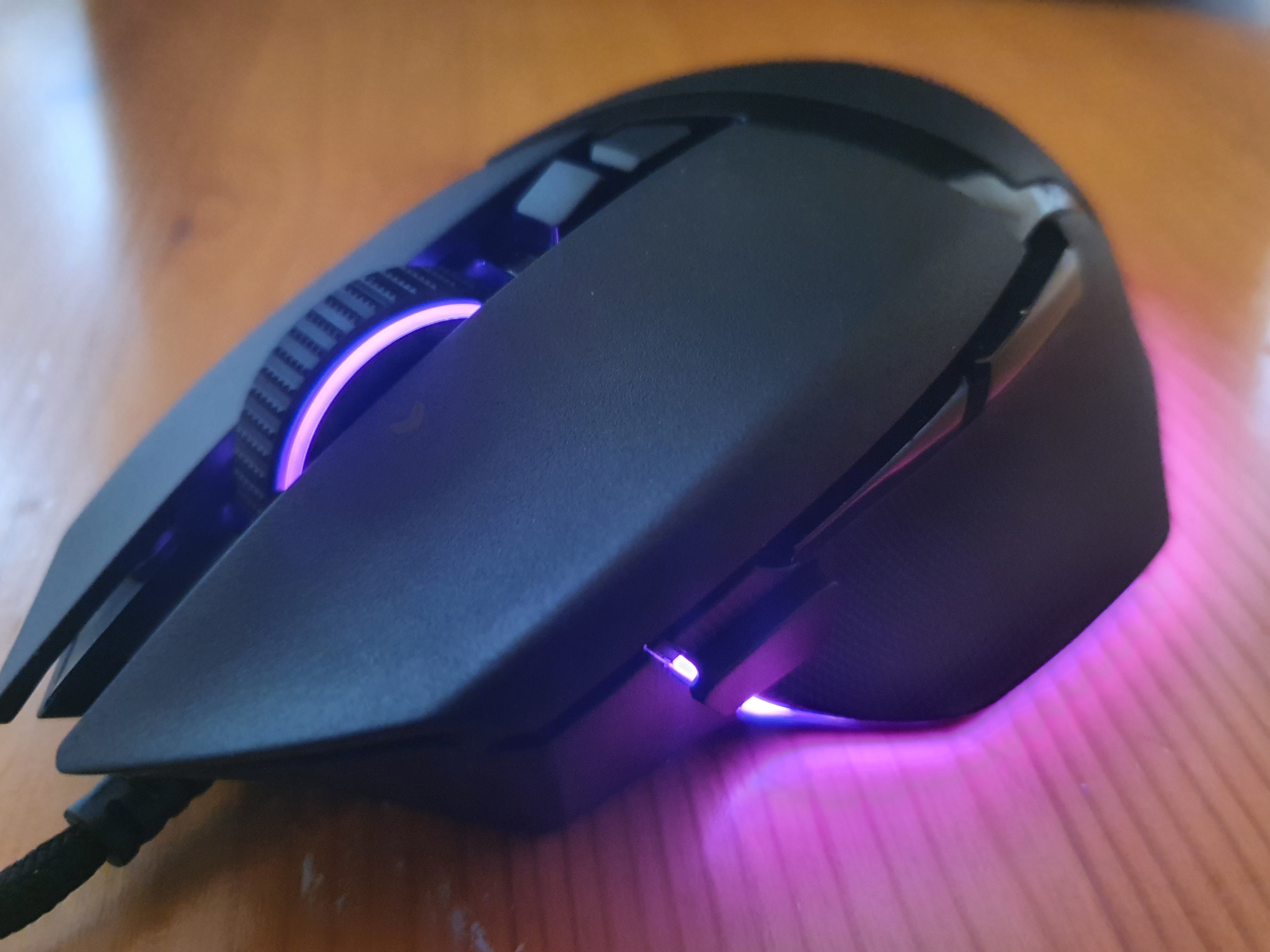
Pros
- The Razer Focus + sensor gives faultless performance
- Scrolling is made simpler with the HyperScroll Tilt Wheel
- The RGB lighting looks fantastic
Cons
- It’s quite heavy and bulky
- You’re limited to wired connectivity only
Price When Reviewed:
69.99
Thanks to its extremely comfortable design, this right-handed mouse is a pleasure to use for extended gaming periods. Among the features that make it so comfy are an ergonomic thumb rest that elevates your thumb off the surface you’re playing on, two highly tactile injection-molded grips on either side, and 11 well-placed, easy-to-reach buttons.
The Razer Basilisk V3’s hardware also performs handsomely. In our review we thought its 24,000 DPI sensor tracked flawlessly, and the buttons, which feature second-generation Razer Optical Switches, responded very quickly. The Basilisk V3 also has one of the best scroll wheels of any budget mouse we’ve come across, allowing you to switch between additional scroll modes, including a Free-Spin Mode and Tactile mode with the touch of a button.
Read our full
Razer Basilisk V3 review
FAQ
How much should I spend on a gaming mouse?
When it comes to what you should pay, there’s really no one price that fits every gamer. Although, as a general guide, you shouldn’t pay more than $90 for a budget gaming mouse—that being the absolute maximum cost of the most feature-stacked budget gaming mice you can get.
Traditional wired gaming mice with six-button configurations tend to be some of the most affordable these days, with excellent value-for-money options like the Logitech G203 Lightsync, providing gamers with just about everything they’d want for casual gaming for around $25. Expect to pay a little more for a wireless mouse, such as the $50 USD Keychron M3 Wireless, whose tetherless design makes it a much more portable device.
What shape mouse do I need?
Many budget gaming mice share the same design as their premium counterparts, so chances are you may already be familiar with a design you like that feels comfortable. If you’re starting from scratch, first off you’ll want to find a mouse with a shape that fits your dominant gaming hand. There are three main shapes: left-handed, right-handed, and ambidextrous.
Left and right-handed mice are just what their names suggest—mice designed to accommodate left or right hands. These mice come with design characteristics that provide advantages to left- or right-handed users, including curves to follow the contours of their hands and button configurations that can be more easily reached.
Alternatively, ambidextrous mice are designed to be used by either hand. These mice sport a more neutral shape, which is usually quite symmetrical. Ambidextrous mice are quite often favored by competitive gamers who like the predictable way they move.
What size mouse is right for me?
Just like a new pair of sneakers, you’re going to be spending a lot of time with your gaming mouse, so if it’s a lousy fit you’re not going to be comfortable and that’s going to affect your performance. Mice tend to fit into three main categories: small, medium, and large. To find a mouse that best fits your hand size you can use this simple size guide:
- Small gaming mouse: Length: Less than 6.7 inches; width: 2.9 to 3.3 inches
- Medium gaming mouse: Length 6.7 to 7.9 inches; width; 3.9 to 4.3 inches
- Large gaming mouse: Length 7.9 inches; width; 3.9 to 4.3 inches
What mouse suits my grip style?
The way you hold your mouse should fit into one of three main grip styles: a palm grip, claw grip, or fingertip grip. While you can essentially ignore your grip style altogether and play with any gaming mouse you choose, if you’re looking to maximize performance, you’ll want a mouse that gives you the most control for your grip. Here’s a guide for what to look for:
- Palm grip: Long, flat mice tend to be a better fit and more comfortable
- Claw grip: Narrower and smaller mice tend to suit this grip style
- Fingertip grip: Lighter mice are often preferred by fingertip grippers to reduce strain
How many mouse buttons do I need?
Your mouse’s button count will limit the number of commands and macros you can apply in-game, and it can also affect the mouse’s weight, which can ultimately impact gaming performance.
Ideally, the number of buttons you need should be informed by the types of games you like to play. For example, if you play a lot of first-person shooters, then keeping your mouse’s weight to an absolute minimum with a small button count is of paramount importance. In this case a standard six-button mouse is perfect, providing enough functionality for at least six commands, but optimizing weight for movement and targeting.
On the other hand, if you predominately play role-playing games (RPGs), or massively multiplayer online games (MMOs), a mouse with from 10 to 18 buttons is preferable since you’ll have more options for the myriad commands these games require. These days you can also get mice like the Roccat Kone XP that allow you to customize buttons with extra functions, which greatly increases the number of commands you can deploy.
What DPI sensor should I look for?
When it comes to performance a lot of emphasis is placed on the DPI (dots per inch) resolution of a gaming mouse’s sensor, with manufacturers touting the benefits of top-of-the-line mice with sensors between 20,000 to 30,000 DPI.
With some exceptions, budget gaming mice tend to have sensors that are much lower in DPI resolution than premium models, which by the same thinking should mean they’re a lot less capable. But that’s simply not the case. In fact, budget gaming mice with sensors as low as 8,000 to 12,000 DPI can still track movement faster than what the human eye can perceive, and, with the exception of some competitive gaming scenarios, can be just as capable performers.
The takeaway is, while it doesn’t hurt to purchase a mouse with the highest DPI sensor as your budget will allow, you should also place just as much importance on other factors like the mouse’s weight and its button configuration, which can be just as important as your mouse’s sensor when it comes to performance.
How light should my mouse be?
Weight comes down to personal preference. Some gamers (especially those that play FPS games) swear by lightweight mice for quicker movement and aiming and to prevent soreness in long gaming sessions, while others prefer the consistent feeling of a heavier mouse.
That said, manufacturers continue to make lighter mice each year. This year we’ve seen a bucket load of new releases that weigh much less than their predecessors—some six-button mice are even breaking the previously unheard of 60-gram mark.
You may find it difficult to find a budget mouse that light, since the lightest mice usually carry the most premium price tags. A more realistic weight is anything below 100 grams, it being kind of an unspoken benchmark for optimal mouse weight among serious gamers. The HyperX Pulsefire Haste 2 is one mouse that is extremely lightweight for its $89.99 price tag weighing just 61 grams.
What’s the best budget gaming mice for kids?
Most kids have smaller hands than adults, so if you have kids, you’d be best advised to get a compact gaming mouse like the Razer Viper Mini, Corsair Scimitar Pro, or Logitech G203 Lightsync.
In addition to moderately sized dimensions, these mice pack gaming-grade sensors and quick switches in their buttons so your kids won’t miss out on any performance advantage in games. If you have older teenagers, any medium-sized gaming mouse like the HyperX Pulsefire Haste 2 will do just fine, since older teenager’s hands tend to be proportionally as big as most adults.



